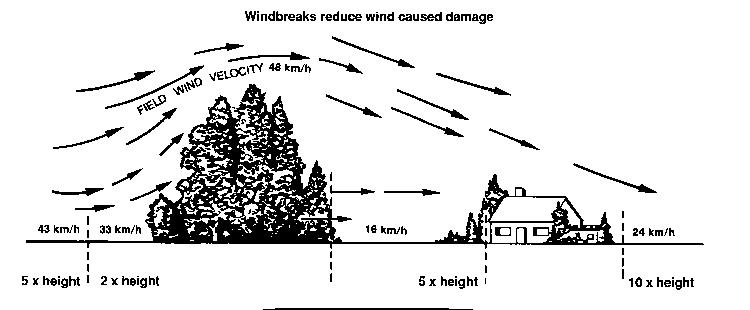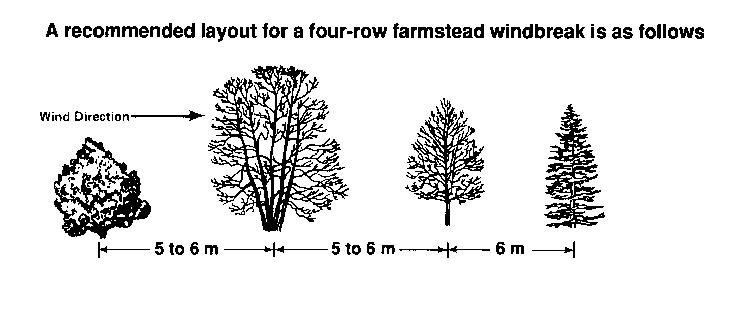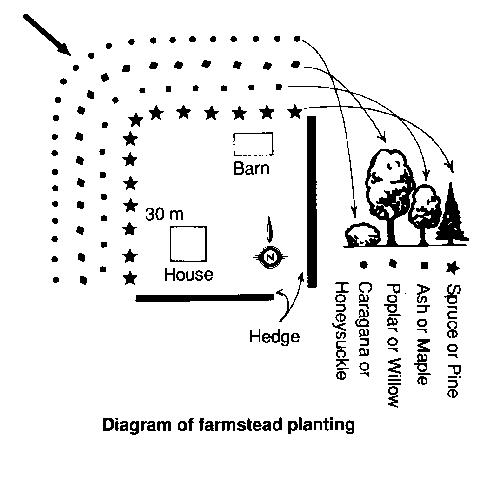| | Farmstead shelterbelts | Field shelterbelts | Roadside hedges | Planting | Maintenance of older shelterbelts | Topping
Windbreaks reduce wind speed by forcing the air currents up and over the windbreak, leaving areas of relative calm on the protected side. In Alberta, the prevailing wind comes from the northwest.
Shelterbelts serve several purposes:
- farmstead shelterbelts for the protection of the farmstead
- field shelterbelts for protection of soil and crops
- roadside shelterbelts for prevention of snowdrifts on roads.

Farmstead Shelterbelts
When a farmstead shelterbelt is to be planted, the following three points are of prime importance:
- Enclose a large enough area, so that all buildings and areas of activity can be protected without crowding and with an eye towards future growth (5-10 acres).
- Plan a shelterbelt of not less than three rows.
- Always include a hedge and a row of evergreens.

| Tall Hedge | Tall deciduous | Small deciduous | Evergreen |
| (fast growing) | (fast growing) | (slower growing) | (slower growing) |
caragana
50 cm in the row | Northwest poplar
3 m in the row | Manitoba maple
3 m in the row | white spruce or Colorado spruce
3 m in the row |
OR
Mayday
150cm in the row | OR
Brooks poplars
3 m in the row | OR
green ash
3 m in the row | OR
Siberian larch
3 m in the row |
OR
honeysuckle
1 m in the row | OR
Willow
3 m in the row OR | willow
3 m in the row | OR
lodgepole pine or Scotch pine
3 m in the row |
OR
lilac
1 m in the row |  |  |  |
Field Shelterbelts
The establishment of a field shelterbelt requires a considerable amount of field preparation; valuable farmland has to be withdrawn from production of crops and the immediate strip of land alongside the shelterbelt loses its productivity. These so called iasappedli strips serve to provide nutrients and moisture for the trees. The field windbreak restricts the farmer in using his machinery. These disadvantages should be weighed against the advantages. A field shelterbelt is a significant investment but the results are worth the effort and can be summarized as follows:
- damage to fields from wind erosion is reduced
- crops are protected from winds and direct damage from high wind velocity
- windbreaks act as snow catchers and improve spring moisture conditions

The area that benefits from the shelterbelt lies mainly on the leeward side of the belt. In general this protected area to the leeward is 20 times the average height of the barrier. A field shelterbelt has to be continuous. If there are gaps in a windbreak weather damage is accelerated in areas lying behind the gaps. Therefore, the replacement of failures at an early age is a must.
Recommended trees for field shelterbelt planting are poplars, willow, green ash, caragana, lilacs, siberian larch and spruce.
Where poplar are used for field shelterbelts, the recommended distance between rows is around 4 m. It is recommended that single row of trees be planted at 3 m spacing. This spacing will prevent the trees from early crowding and a vigourous growth rate results.
A hedge of willows, caragana or lilac can be planted along with the poplar. The willow is recommended for good soil sites, caragana for dry sites. The hedge should be planted on the exposed side, 6 m from the poplar.
Hedge plants, such as lilac and caragana, can also be used in field shelter plantings without the rows of poplar trees. However, these hedges are lower and the width of the protected strip is consequently much smaller. A field shelterbelt of this type should be planted at intervals of not more than 150 m.
A field shelterbelt should be laid out in such a manner that livestock will not be able to seek shelter under and between the trees. If livestock occupy the adjacent land parcels the fencing of a field shelterbelt is a must.
Roadside Hedges
Recommendations for roadside hedges are similar to those for hedges in field shelterbelts.
When a roadside hedge is planned, the minimum distance from the centre of the road should be 37-45 m. Many countries have already passed bylaws which make this practice compulsory.
For roadside hedges the following species are recommended:
- On good soil (central & northern regions):
- Willows: laurel leaf and acute leaf planted as a single row at 3 m in row spacing.
- Mayday: planted at 2 m spacing
- Honeysuckle: planted at 1 m spacing.
- On sandier soil (which are less favorable):
- Lilac: villosa and common planted at 1 m spacing
- On dry soils (or soils which have prolonged periods of drought):
- Caragana: planted at 50 cm spacing
- On alkaline soil:
- Silver buffalo berry: planted at 1 m spacing
- Villosa lilac: planted at 1 m spacing
Planting
How to prepare land and plant trees
Cultivate the planting strip at least one year before planting to reduce weed competition. The transplants distributed as shelterbelts material are small and need all possible help to survive the first few years. Trees are shipped in bales with the roots packed in damp peat moss. Plant them as soon as you receive your shipment. If storage is necessary, keep the bales at a low temperature in the shade.
Stake planting rows before the actual planting. Follow the contours of the field with the shelterbelt layout. Plant at the same depth as the plants are grown in the nursery. In case of machine planting, walk behind the planter and check; firm the soil around each tree. Follow the spacing recommendations. Stop planting when wind speed exceeds 30 km per hour.
Care for a new planting
Shallow cultivation is needed for several years. Herbicides can take the place of cultivation, but require special knowledge.
LINURON (50W) at recommended rates applied and watered in before the leaves come out will control most annual weeds.
GRAMOXONE at recommended rates will kill all weed foliage, but can only be applied on older established trees and should not be sprayed on the trees themselves.
GLYPHOSATE at recommended rates will kill all foliage, can only be applied on older established trees, and should not be sprayed on the trees themselves.
Maintenance of Older Shelterbelts
Fencing
Most landowners recognize that newly planted shelterbelts should be protected from grazing, browsing or trampling by livestock. However, when the trees become established the degree of protection sometimes decreases and livestock are allowed to enter the planting site. This practice will cause severe damage to the trees. Cattle and horses browse the foliage from the lower limbs and many even break up entire trees. Grazing within a shelterbelt will also compact the soil, resulting in less infiltration of precipitation and increased runoff. The degree of damage through browsing is directly related to the length of time the shelterbelt is exposed to the livestock. It does not take long for shelterbelts 10 -20 years old to become completely ruined through grazing.
Thinning
Symptoms of an overcrowded shelterbelt are a slowing of growth in height, dead lower branches, and a reduced trunk diameter. Under severe crowding conditions the trees will die at an early age, mainly from lack of moisture. Trees whose vigor has been reduced are prime targets for insect and disease attacks.
Removal of trees or thinning is the proper procedure for saving these shelterbelts by encouraging new growth. Thinning will increase the growing space so that the remaining trees can obtain moisture and expand their crowns.
In multiple-row shelterbelts, thinning can be accomplished by the complete removal of one or more rows of trees, or by the systematic removal of portions of the trees in one or more rows, as in the case of multiple-stem trees like the Manitoba maple and willows. The removal of an entire row is the simplest form of management and is probably the one most frequently used. Shelterbelts are, as a rule, uniform in composition and the removal of whole row of trees does not disfigure the belt.
In single-row shelterbelts the danger of overcrowding is less pronounced since the root system can use the fringe area on both sides of the belt. However, when spruce are spaced at 120-180 cm it is recommended that thinning be done by removing every second tree.
Topping
Removing the tops of fast growing trees such as poplars and willows is not recommended. This practice leaves the trees deformed for the rest of their lifespan. Topping also shortens the life of the tree because the large wound opens the trunk allowing entrance of decay organisms.
Information prepared 1992 by Alberta Agriculture and Food.
Source: Agdex 277/20-2. |
|